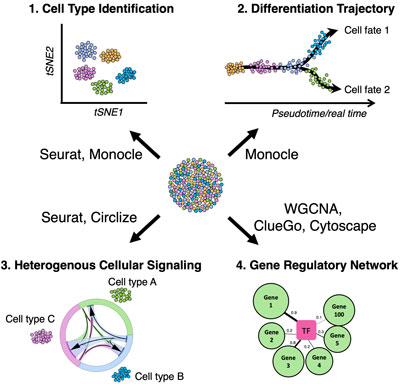Tissue Engineering and Stem Cell Therapy: Optimization of chondrogenesis of human pluripotent stem cells via Single-cell transcriptomics and bioinformatics

Figure 1. Representative Bioinformatic analysis methods for scRNA-seq.
Osteoarthritis (OA) is a debilitating joint disease characterized by cartilage degeneration as well as pathologic remodeling of other joint tissues. Cartilage has limited intrinsic healing capacity, motivating the application of stem cells for regenerative therapies. In this regard, the advent of human induced pluripotent stem cells (hiPSCs) has served as a major breakthrough towards cartilage regenerative therapies and in vitro disease modeling for OA drug discovery due to their nearly unlimited proliferation and pluripotentcy. However, the therapeutic application of human induced pluripotent stem cells (hiPSCs) for cartilage regeneration is largely hindered by the low-yield of chondrocytes accompanied by unpredictable and heterogeneous off-target differentiation of cells during chondrogenesis.
This project aims to apply single-cell RNA sequencing (scRNA-seq) throughout the process of mesodermal and chondrogenic differentiation of hiPSCs to map the temporal gene expression over the course of hiPSC lineage specification (Fig 1). By exploiting single cell transcriptomics and various bioinformatic tools, we expect to re-construct regulatory gene regulatory network and signaling pathways orchestrating hiPSC chondrogenesis, thereby advancing a further step of cartilage regenerative medicine toward therapeutic applications. This approach will also provide a roadmap for the use of single-cell transcriptomic methods for the study and optimization of other in vitro or in vivo differentiation processes (Fig 2).

Figure 2. (A) Tissue-engineered hiPSC cartilage construct shows heterogenous cell populations (yellow-arrowheads) and chondrocytes (turquoise-arrowheads). (B) Bifurcated chondrogenic differentiation trajectories. (C) Bioinformatic analysis of gene regulatory network using WGCNA identified hubs genes of neurogenesis that leads to off-target chondrogenesis.